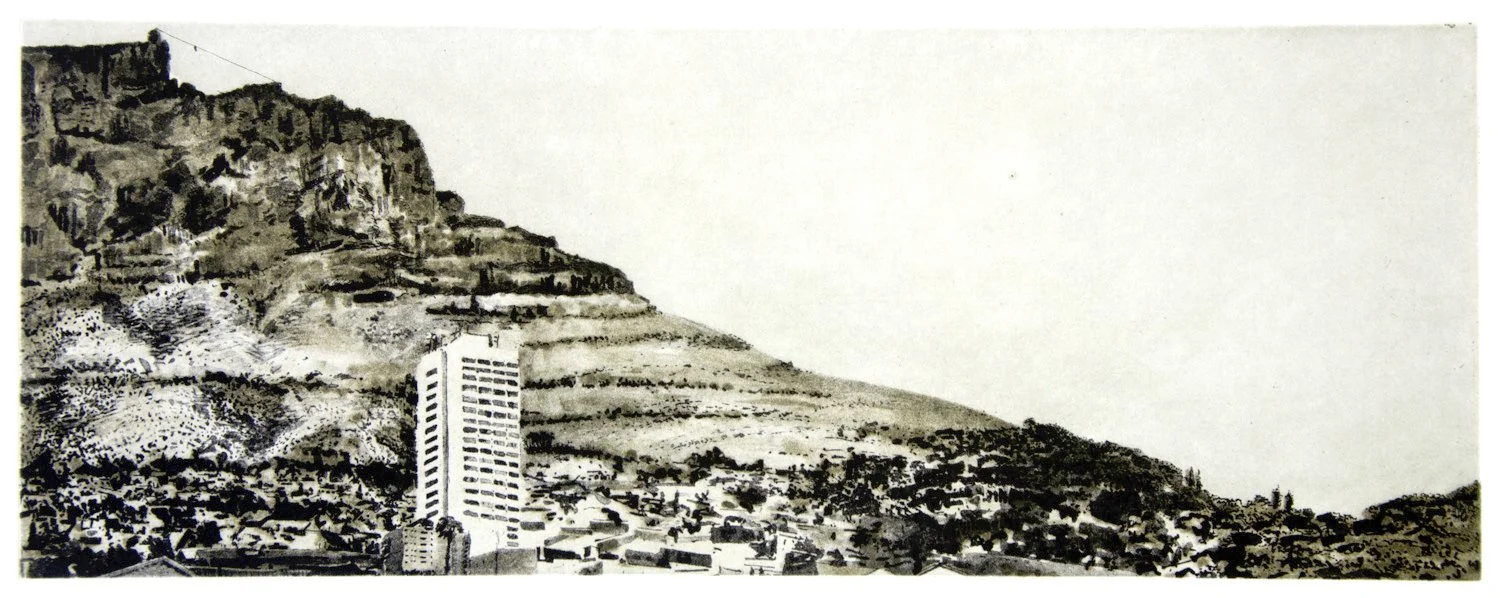Souvenir
Etching with aquatint, produced for Warren Edition’s yearly Edition S.
2012
Plate: Sheet:
Edition: 55
Printed by Warren Editions
‘Cliché’ is a term from printing, after all; clichés help us see, understand, and remember.
Accompanying Statement
My interest in making prints arises in the first place from a love of the specific kinds of lines and marks that are characteristic of the various graphic media. As a lover of books and paper I am stimulated by the idea of multiplying a drawing and sending it into the world. But I have never much liked working out a composition intended for a print and then transferring it to the plate; my initial drawings had always lose something of their freshness in this process. So I had come to Warren Editions with the express desire to react to my surroundings in a direct, spontaneous, unmediated way. I wished to treat the etching plate like a page from my sketchbook. I started work on a series of drawings of my fellow commuters on the train to the city every morning. I drew directly onto brass plates I had prepared with etching ground; I felt solidarity with the coming and going, the river of people streaming to work and home again. I felt satisfied that I was 'reacting', that I was engaged, that I was in the midst of life. But upon entering the studio each morning, there it lies, the mountain with its changing moods and unchanging presence. I started drawing the mountain. I immediately had to start adding sheets of paper to the one I had started on, because the mountain is too big to contain.
When Zhané Warren invited me to participate in Edition S, I was thrilled that she suggested I draw the view from the studio. The idea of working directly onto the plate excited me; this would be direct, I thought. Unmediated. For a moment I thought I could use the polished plate as a Claude glass onto which I would be able to trace the reflection of the view, as I had heard other artists have done, though in the end it seemed simpler to simply draw what I saw. And then when the first print was pulled, my heart sank, because it was the wrong mountain. In my excitement about the drawing and the process and having a master printer print my work, I had forgotten the first elementary characteristic of prints: it is a mirror image of the drawing on the plate. So what had recognizably been a bit of Table Mountain with the cable car and the soft slopes and the tree lines fraying the lower ridges had become a romantic view of a generic mountain. Swiss, we thought it looked. We agreed that I would have to start over.
When I returned to the land without mountains we started talking of other ways to collaborate. The proof print on my studio wall was a memento of a happy work period, and a teasing reminder of fallibility. Zhané proposed executing the project as a photopolymer etching; in this way my geographic location would be no objection. I could make a long-distance drawing. Consulting my preparatory sketches, and the first proof print, and the pictures I had taken with my phone, I started working on some new drawings, in ink this time; two drawings of the same view for the two colour plates. What I found however was that I was also consulting my memory and using these other visual sources as supplements; I remembered the 'soft slope' Zhané kept mentioning in the studio and I searched for it in my contour drawings; I remembered the dark and light planes as the mountain started casting its shadow in the afternoons, and I emphasized the tonal difference I found in my photographs. I was not, I realized, reacting to what I saw unmediated. I was constructing, imagining, inventing. As all memory is construction, I realized, and as even the most naturalistic depiction is also invention. Some neurologists now say that our purest perception is itself a construct of our brains, mediated by our cultural environment. This means that perception and depiction are also, from the start, collaborations. Which makes the collaborative print a particularly satisfying form with which to meditate on the puzzles of distance and proximity, absence and presence, naturalism and abstraction, mimesis and invention.
When I started writing this statement I returned to a question I had put myself at the outset: who needs another picture of Table Mountain? Isn't it a bit of a cliché? But then, I remind myself, who needs another design of a chair or a typeface? Who needs another baby? We find ourselves in the world and we react to it - these are life-affirming impulses. ‘Cliché’ is a term from printing, after all; clichés help us see, understand, and remember. What I have made in collaboration with Warren Editions is a picture postcard: I am here now, and this is what I see.
Rotterdam, 2012
